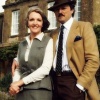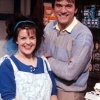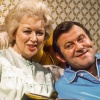In 1975 Bob Larbey and John Esmonde tapped into the fantasies of a section of the British public desperate to break out of their daily grind. Many sitcoms of the time exploited the misery that was (and still can be) a 9-to-5 office job - underpaid, undervalued and with a tyrant boss – and the comedy came out of the protagonist being stuck in that situation. Along came Tom and Barbara Goode, who did what thousands of people would secretly love to do; tell their boss to stick it, and strike out on their own.
Tom Good (Richard Briers) wakes up on the morning of his 40th birthday knowing something has to change. After what is to be his final day at work as a draughtsman, where he designs plastic animals for cereal packets, he spends the evening trying to work out what it is he is looking for in life. Finally it dawns on him, and after giving his wife Barbara (Felicity Kendal) time to get used to his suggestion, the pair embark on a self-sufficient lifestyle; growing their own food, making their own clothes and generating their own electricity. Anything they can’t make themselves they attempt to barter for, using their crops.
Whilst the Goods themselves are immensely likeable and therefore watchable, what makes The Good Life so much fun is the relationship the Goods have with their neighbours, the Leadbetters. Margo (Penelope Keith) is an unashamed social climber; accustomed to a certain way of life paid for by her husband and with a definite sense of what she considers acceptable and what isn’t. Her greatest worry is losing her social standing in front of the rest of the residents of The Avenue, Surbiton where the Goods and the Leadbetters live. The Goods and their back garden full of livestock and vegetables are a constant source of embarrassment to Margo; she believes that Tom has subjected Barbara to a life of poverty, and despite Barbara’s protestations that the Goods made the decision to step out of the rat race together, Margo can be both disapproving towards Tom, and patronising to ‘poor Barbara’ on occasion for this reason.
Jerry (Paul Eddington) is Margo’s husband. He works hard for the same boss that Tom walked away from, and whilst he is higher up the corporate ladder than Tom ever was, he will still do any amount of crawling necessary in his professional life to progress closer to the top. When he gets home in the evening, all he wants to do is relax and unwind, but between Margo’s nagging and the Goods’ various allotment-related crises there isn’t much chance of that. He initially believes that Tom has lost his mind; throwing away a well-paid job to live as ‘peasants’(as he often jokingly calls them), but as Tom and Barbara forge ahead, and show themselves to be not only succeeding, but content with it there are moments when you feel Jerry is somewhat envious. You also see that he sometimes envies Tom for another reason as well; he’s always had a little bit of a crush on Barbara…
Esmonde and Larbey were inspired to write The Good Life after Larbey’s own 40th birthday led them to think about how turning 40 is a milestone in most people's lives. They wrote it with Brier specifically in mind to play Tom, but with a view to asking Peter Bowles to play Jerry. Bowles was unavailable however, and Paul Eddington came on board. The writers then saw Kendal and Keith performing on stage together, and knew they had found their Barbara and Margo.
30 episodes were made and broadcast over four series on the BBC, from April 1975 until June 1978, plus a Christmas Special in 1977, and an episode written for the Royal Command Performance in 1978. They were shaped by John Howard Davies, who as a prolific BBC producer, and also under the titles of Head of Comedy and Head of Light Entertainment at the BBC, had a hand in Monty Python’s Flying Circus, Fawlty Towers and Steptoe and Son amongst plenty of others.
Each episode is packed full of laughs, and the occasional tender moment. Tom and Barbara clearly adore one another, and the love and support that the two very different couples have for one another is shown in many an episode. For example; when Tom puts his back out, and a storm threatens to ruin the Goods’ first harvest, Margo (clad head to foot in a yellow sou’wester and matching waterproof outfit) and Jerry (with a foot in a plaster cast after an argument with a Land Rover on holiday) pitch in and help them rescue it. The Leadbetters also provide a helping hand, much to Margo’s initial dismay, when the Goods’ pig, Pinky goes into labour. Self-sufficiency is the over-riding theme in this programme, but it’s moments like these that prove that friendship is really what The Good Life is all about.










Do You Remember The Good Life (UK)?
Do You Remember The Good Life (UK)?